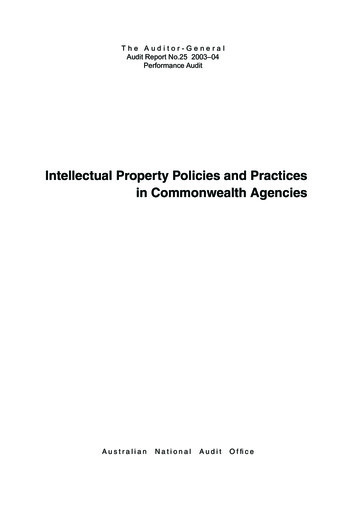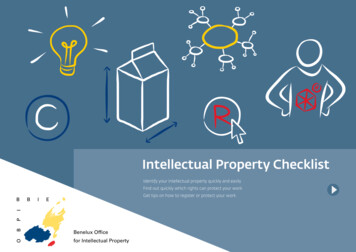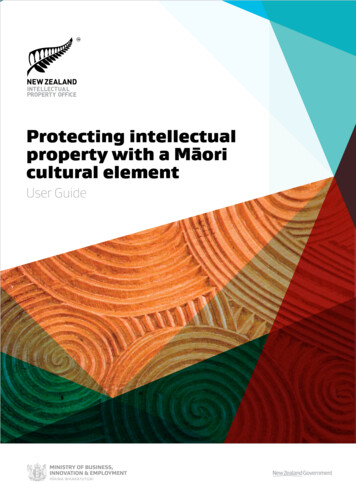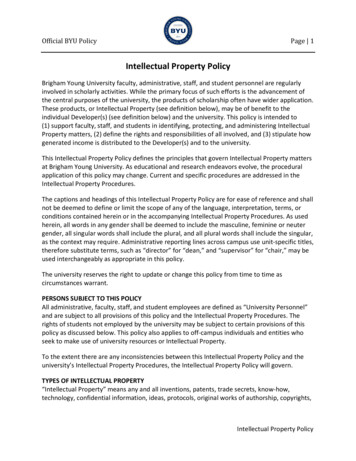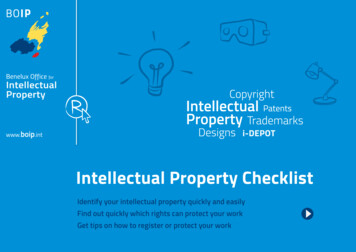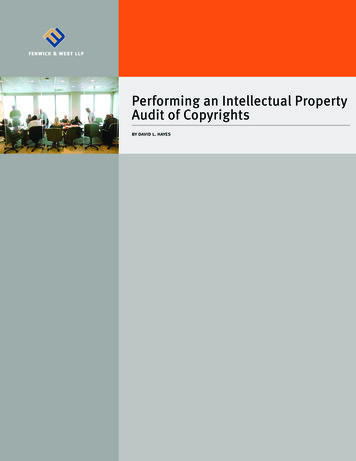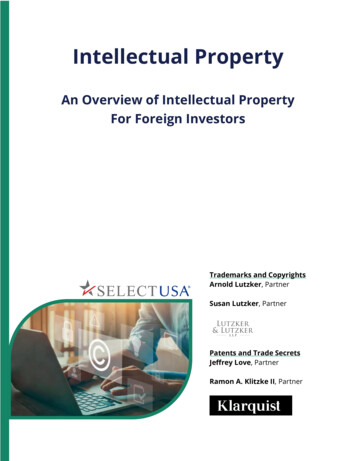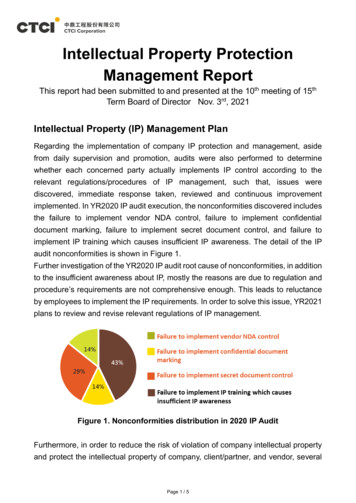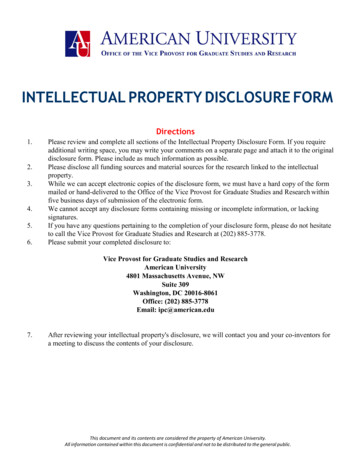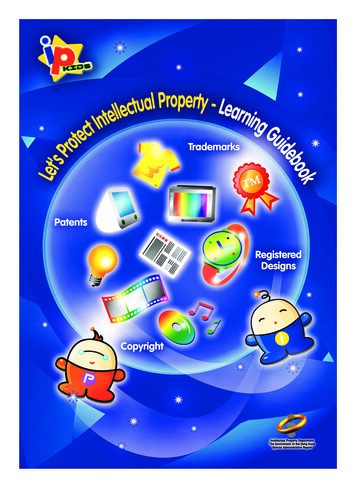
Transcription
Let’s Protect Intellectual Property Learning GuidebookContentHow to Use this Booklet?1True or False2What is Intellectual Property?3Copyright Lesson 1 : What is Copyright? Who are the Copyright Owners?4Copyright Lesson 2 : The Exclusive Rights of the Copyright Owners5Copyright Lesson 3 : Copyright Protection Period6Copyright Lesson 4 : Photocopying in School7Copyright Lesson 5 : Computers and Software8Copyright Lesson 6 : Copyright in Works Created by Teachers and Students9Workshop 110What is a Trademark?11Workshop 212What is a Patent?13Workshop 314What are Registered Designs?15Workshop 416Intellectual Property DepartmentGovernment of the Hong Kong Special Administrative RegionSeptember 2003 Hong Kong Special Administrative Region Government 2003Reprinted in October 2007All rights reservedThis publication may be copied, distributed or exhibited in any form for noncommercial use without the prior permission of the Government of the Hong KongSpecial Administrative Region provided that the following notice appears in the work:This material is taken from “ Let's Protect Intellectual Property - Learning Guidebook ” 2003 and is used with the permission of the Government of the Hong KongSpecial Administrative Region.“ IP Interactive Zone ” Webpage: http://www.ip-kids.gov.hkPrinted by the Government Logistics DepartmentThe material in this publication does not constitute legaladvice and the Government of the Hong Kong SpecialAdministrative Region does not accept any liability forany loss or damage caused to any person relying onany information or omission in the publication.
How to Use this Booklet?The Objectives of this Booklet“Let’s Protect Intellectual Property - Learning Guidebook” is designed to complementthe Intellectual Property Department’s webpage “ IP Interactive Zone ” (http://www.ip-kids.gov.hk). With the objective of providing a teaching material on intellectual property, this booklet helpsstudents understand intellectual property rights through various interactive activities, and stimulatesoriginal and creative thinking.The TargetThis booklet is written for students from primary five to junior high school level. Teachers can select suitablecontent according to the school’s needs and the levels of the students.How to Use this Booklet?This teaching kit is designed for learning through students’ active participation and their interactions with teachers.Teachers can photocopy and distribute the “True or False” section to test the students’ understanding of thesubject. This section enlivened by pictures describing different situations and characters, precedes a briefexplanation of the relevant concept of intellectual property.The teaching material covers four main themes : copyright, trademarks, patents and registered designs. Eachtheme is introduced by cartoons depicting different situations that require discussion between the teachers andstudents. What follows the discussion is a workshop, which allows for different learning modes such as roleplays, creation projects, group competition and picture collection; all these serve to enhance the students’understanding of the topics as well as their creativity, thinking and observation power.Teachers should consider students’ interest and ability in planning the activity and selecting material from the kit.They can photocopy this booklet for instruction and discussion with students.During the activities, teachers should be open-mindedin guiding the students to consider and analyzequestions from different angles, including those ofcopyright owners and copyright work users, with a viewto developing in them a correct understanding andattitude towards intellectual property as well as a lovefor creative and original thinking.This booklet is also available on the webpage of “IPInteractive Zone” (http://www.ip-kids.gov.hk). Teachersare welcome to copy and distribute pages to theirstudents for educational purposes.1
True or FalseTrue or FalseThis activity aims to test your understanding of intellectual property rights. Study the following scenarios carefully, andconsider whether the following statements are right or wrong. If it is true, put a “ ” into the box. If it is false, put a " ".Situation 1:An artist is copyingan artwork of anotherartist for the purposeof sale. There is noinfringement ofcopyright.Situation 2:Siu Keung is creatinghis own cartooncharacter. He ownsthe copyright.Situation 3:Computer programsare not protectedby copyright.Situation 4:Karaoke operatorsmust pay the licensingfees or royalties for theplaying of the songs/musicin running the business.2 Answer at next page .Situation 5:The songs composedby primary schoolstudents are protectedby copyright.Situation 6:The sale ofrecorded TVprogrammesis an act ofcopyrightinfringement.Situation 7:The whole textbook isphotocopied in thephotocopying shop.There is no infringementof copyright.Situation 8:Shakespearedied more than300 years ago.His works are notprotected bycopyright.
What is Intellectual Property?What is Intellectual Property?IVYThe term “intellectual property” generally refers to the intangible property rights,which are distinct and separate from the physical property rights of the tangibleobjects. Intellectual Property includes trademarks, patents, copyright, registereddesigns, etc. Intellectual property is important to our daily lives: brand names,logos on clothes, articles in the newspaper, TV programmes, pop songs, filmsand fashion designs have a strong connection with intellectual property rights.What is Protected?The protection of intellectual property means the protection of creativity. But not allideas are protected. For example, to balance the interests of different sectors of society,a pharmaceutical invention may be protected by patent registration while a specialmedical treatment of a disease is not protected.Why is Intellectual Property Protection Important?PERRYOnly by protecting the efforts of the writers, artists, designers, programmers, inventorsand other talents, we can create an environment where creativity can flourish andhard work can be rewarded.“True or False” Answer :Situation 1Situation 2Situation 3Situation 4Situation 5Situation 6Situation 7Situation 8IP TipsIn Hong Kong, the Intellectual Property Department is responsible for assisting the SAR government to formulate policies andlegislation on intellectual property and to carry out public education programmes. The Customs and Excise Department is responsiblefor fighting any criminal acts of infringement of intellectual property rights.3
Copyright Lesson 1 : What is Copyright?Who are the Copyright Owners?Drawing 2I have thought of a story buthave not written it down. Is itprotected by copyright?Drawing 1I have taken some pictures of the scenery. Are theyprotected by copyright?DiscussionCornerReferring to the two pictures, which work do you think is protected bycopyright? Who is the copyright owner?What is Copyright? Who are the Copyright Owners?IVYCopyright protects the expression of ideas, not the underlying ideasthemselves. The expression of ideas recorded in some tangible things orworks are protected by copyright. Written records, sound recording, picturesand photographs are some of the examples.PERRYOriginal literary works, drama, music, drawings, sculptures, photographs, software,sound recording, films, broadcasts, cable programmes and layouts of publishedworks are protected by copyright. Normally, the creator of a work is the firstcopyright owner of the work.IP TipsCopyright need not be registered. It arises when a “work” is created. In Hong Kong, the use of “ ” is not a sign of registration.Instead, it only serves to remind people to respect copyright.4
Copyright Lesson 2 : The Exclusive Rights ofCopyright OwnersDrawing 2I h ave c o m p o s e d a nopera. I plan to have apublic performance of myopera in an opera house.Drawing 1I have uploaded my self-composed songs onto my personal webpage so that they can be downloaded by otherpeople.DiscussionCornerApart from the two examples, how can copyright owners use theirwork?The Exclusive Rights of Copyright OwnersIVYCopyright owners enjoy some exclusive rights over their works, including theright to copy, issue copies to the public, rent computer programs or soundrecording to the public*, make copies available to the public via the Internet,broadcast the works by wireless means or cable, and adapt the works. Forexample, they can translate their works in another language or change a 2dimensional drawing into a 3-dimensional object.* The rental right is planned to be extended to comic books and films in early 2008.PERRYCopying, adapting and broadcasting of a copyright work without thelicence(s) of the copyright owner(s) are examples of acts of infringementof copyright.IP TipsAn act of "secondary infringement" may be committed when a person, without the licence of the copyright owner(s), imports,exports or sells pirated copies of a copyright work. Such action may result in criminal prosecution.5
Copyright Lesson 3 : The Protection Period ofCopyrightDrawing 1I’m a great poetwho has written somany poems. Mydescendents willpossess the copyright of my poemsforever.Drawing 2Beethoven died more than a hundred years ago.If I perform his composition in public, I will notinfringe any copyright.DiscussionCornerReferring to the two pictures, who do you think is right? Why?The Protection Period of CopyrightIVYThe copyright of a work does not last forever, but only for a certain period.The duration of copyright is different for different types of copyright works.PERRYThe copyright of a literary, dramatic, musical or artistic work, in general, lasts until fifty yearsafter the creator of the work dies.The copyright of a sound recording expires fifty years from the end of the calendar year inwhich it is made, or if during that period it is released, fifty years from the end of the calendaryear in which it is released.The copyright in a film expires fifty years from the end of the calendar year in which the last oneamong the following persons dies: the principal director, the author of the screenplay, theauthor of the dialogue and the composer of music specifically created for and used in the film.IP Tips6Copyright, like other property, is capable of passing upon the death of the copyright owner(s). In other words, the heirs to copyrightwill become the copyright owners.
Copyright Lesson 4 : Photocopying in SchoolDrawing 2This book has been out of print for many years. Ithink it is okay to copy it and distribute the copiesto my students.Drawing 1This book is too expensive and I cannot affordit. I should seek the helpof my teachers becausethey should have theright to photocopybooks.DiscussionCornerReferring to the above two pictures, do you think they can do so?Why?Photocopying in SchoolIVYMany schools have entered into licences with Hong Kong Reprographic RightsLicensing Society which allow their teachers and students (upon instructionsof the teachers) to photocopy centain portions from books for teaching andlearning purposes. The Hong Kong Copyright Licensing Association has alsogranted a licence to schools for making photocopies of a number ofnewspapers and magazines for instruction purposes subject to certain limits.PERRYWhether or not schools have entered into the above licences, teachers are allowedto copy literary and artistic works for the purpose of setting examination questions.In addition, teachers and students are allowed to deal with reasonable portions ofcopyright works (which includes copying the works) in a fair manner for teachingand learning in certain courses provided by their schools. Broadly speaking, for anydealing with a work to be considered as ”fair”, it should not harm the reasonableinterests of the copyright owner.IP TipsIn general, copyright law only permits schools to photocopy limited portions of copyright works for teaching purpose. Schoolmay consider obtaining appropriate licences to facilitate their teaching activities. Teachers may also consider creating their ownteaching material so that they will not need to copy others’ copyright works.7
Copyright Lesson 5 : Computers and SoftwareDrawing 2There are many pictures and texts over theInternet. I can email them to my classmates fortheir reference.Drawing 1The school does not have this learning software. I caninstall such software (which I have used in my computer at home) in the school’s computers, so that myclassmates can share it.DiscussionCornerReferring to the above two pictures, do you think their actions areright? Why?Computers and SoftwareIVYSchools are not allowed to use any unlicensed software in their computers.Students should not bring their own computer software to school and install it inthe school’s computers, whether with or without the teachers’ knowledge. Onthe other hand, the schools should not lend their software to their teachers andstudents for use at home.PERRYThe works over the Internet may be protected by copyright, so they may not be copied at yourwill. Moreover, making infringing copies of copyright works available to public via the Internet isillegal. Copying the texts, pictures, photos or sound and uploading them onto a personal webpagewithout the permission of the copyright owner(s) are also acts of infringement.IP Tips8Intellectual property rights are not only protected in Hong Kong. Since Internet may be accessed without geographical boundaries,anyone anywhere can surf the Internet. Copying of any information from the Internet may infringe the copyright laws of foreigncountries.
Copyright Lesson 6 : Copyright in Works Created byTeachers and StudentsDrawing 2I can photocopy the teaching material given by MissChan and distribute the copies to the students ofother schools.Drawing 1These works are created by my students. As a teacher,I have the right to copy their work.DiscussionCornerReferring to the above two pictures, do you think they are right?Why?Copyright in Works Created by Teachers and StudentsIVYThe works and teaching material created by teachers are protected bycopyright. If the teachers are full-time employees, then the copyright of theirworks created in the course of employment belongs to the schools, not theteachers themselves.PERRYStudents are not the employees of the schools, so they can own the copyright of theirworks. The schools cannot make their works available to the public or copy them withoutthe students’ permission.IP TipsIf the teachers want to own the copyright of the works created by them for the schools, they can negotiate with the school authorityand reach a mutual agreement.9
Workshop 1最新電腦軟件 20 X 1 50 X 3 100 X 7Role-play GameTeaching ObjectiveSituationThis activity allows the students to have a betterunderstanding of copyright by role-playing the situationsuggested below.Outside the shopping arcade, there are two hawkers doingbusiness without business licences. They are sellinggenuine CDs and pirated CDs respectively. Inside thearcade, there is a shop selling pirated copies of computersoftware. Two customers are inside. One is paying moneyto the shop owner for buying the pirated copies. The otherone just looks around. At that moment, the Customs andExcise officers arrive at the scene to combat the activitiesrelating to the dealings of pirated copies.MethodThe teacher should instruct the students to role-play andafterwards lead an interactive discussion.CharactersTwo hawkers without business licences, a shop owner, two customers and many Customs and Excise officers.Brainstorm1. Who should be arrested by the Customs and Excise officers? Why?2. Whose interests are protected by the actions of the Customs and Excise officers?Webpage ProductionTeaching ObjectiveThis activity is to encourage the students to create theirown personal webpage and to become onlinepublishers. By doing so, they will come to realize thattheir works are protected by copyright. This will alsoenhance the creativity of the students.MethodStudents can design their personal webpage withphotos, texts, graphic or sound created by themselves.If they do not know how to create a webpage, they canuse a blank paper to simulate the webpage, and write,draw or paste the content on it. After the production,teachers can ask them some questions to enhance theirunderstanding of copyright.Brainstorm101. Why are the webpages designed by the students protected by copyright?2. If you want to put your classmates’ works onto your personal webpage, what should you do?
What is a Trademark?Drawing 1The competitor’s brand C. C. Susu is very popular. Iplan to produce a series of handbags and use “C. C.Zuzu” as their brand name.Drawing 2I have registered my trademark in Hong Kong andthus need not waste money to register it in othercountries.DiscussionCornerReferring to the two pictures, do you think their actions are right?What is a Trademark?IVYA trademark is used to identify the goods or services provided by differenttraders. Without the consent of trademark owner, a third party cannot use theregistered trademark or a similar mark on goods or services covered by theregistration.PERRYTrademarks registered in Hong Kong are protected in Hong Kong. If the owners wanttheir trademarks to be protected in foreign countries, they should register them inthose countries.IP TipsTrademarks are signs which can be made up of text, logos, personal names and letters of the alphabet, or a 3-dimensional object,or the combination of them. Such sign should be capable of being represented graphically in order to be registered. It shouldhowever be noted that any words that are direct description or giving praise of the goods and services applied for will not beregistered.11
Workshop 2Role-play GameTeaching ObjectiveSituationThis activity aims to further the students’ understandingof trademark protection by role-playing the situationsuggested below.MethodA hawker is selling toys with fake trademark in the street.Ming and Flora walk past. They find the toys are muchcheaper than those with genuine trademark. Theyhesitate whether they should buy some and take themhome.The teacher should instruct the students to role-play andafterwards lead an interactive discussion.CharactersMing, Flora, a hawkerBrainstorm1. Do you think Ming and Flora should buy the toys with fake trademark? Why?2. Who will suffer loss from the hawker’s sale of toys with fake trademark?Trademark Design Group Competition12Teaching ObjectiveMethodThe students will gain an understanding of the effortsrequired in the creation of trademarks and will improvetheir teamwork by participating in a trademark designcompetition.Students are divided into six groups to design thetrademark of a newly created fashion label “ Alice &Tommy ”. They can apply different elements onto thetrademark, such as patterns, colours, alphabets, figuresand so on.Each group should complete the trademark designwithin a given time. Five students will be appointed asjudges to choose the best design.
What is a Patent?Drawing 2I have copied the idea of a smart vacuum cleanerinvented by another inventor. Only the appearance is slightly different. I think I can register apatent for it.Drawing 1This “smart home” is my invention. I should discloseit to the public via the media prior to patentregistration.DiscussionCornerReferring to the two pictures, what is wrong with their views?What is a Patent?IVYPatent registration protects inventions. A patent gives some exclusive rights tothe inventor(s) of an invention or its subsequent owner(s). A patent holder canmake and use the patented invention or place it on the market. Other peopleare prevented from making, using, selling and importing his patented inventionand his investment is protected.PERRYPatents are only granted to new, inventive and industrially applicable inventions.Generally speaking, if any invention is disclosed to the public prior to the application ofpatent registration, the inventor will not be given any exclusive rights.IP TipsTo encourage the development of new technology, the patent system grants some exclusive rights to the inventors for a certainperiod to develop their inventions.13
Workshop 3Let’s become inventorsTeaching ObjectiveThis activity is to encourage the students to express their creative ideas by asking them to come up with their own newinventions. This activity aims at enhancing the students’ understanding of the importance of patents.MethodStudents can draw their new inventions on a sheet of paper. The new invention should meet three requirements. Itmust be new, inventive and industrially applicable.My invention is .Brainstorm1. What are the functions of your invention?2. How does your invention meet the three requirements: new, inventive and industrially applicable?3. Do you think your invention has any commercial value? Why?RemarkStudents can use other tools to show their inventions.14
What are Registered Designs?Drawing 1I have designed some new fashionable clothes which are made withnew technique, but I cannot stopothers from copying the design.Drawing 2Since creation is protected by intellectual property rights, I can disclose my new design of a diamond necklace to the public before registering thedesign.DiscussionCornerReferring to the two pictures, do you agree on their viewpoints? Why?What are Registered Designs?IVYIn general, any new shapes, configuration, patterns or ornaments which areapplied to an article by an industrial process and whose features appeal toand are judged by the eyes are called designs. They can be protected asregistered designs upon registration.PERRYOnly new designs are registrable. If they are disclosed to the public before the applicationfor registration is filed, the registration will become ineffective even if it is granted.IP TipsFabric patterns, the appearances of watches, jewellery, toys, mobile phones and so on can be registered.15
Workshop 4The Collection of PicturesTeaching ObjectiveMethodThis activity is intended to enhance students’understanding of registered designs by collectingpictures.Many goods with registered designs can be found inthe market. You can collect some pictures of such goodsfrom magazines and newspapers.Brainstorm1. Apart from the collection of pictures, can you think of any product designs which can be registered?2. The designs of many goods are very similar. Is every part of the design of goods protected by the law ofregistered designs?Little DesignersTeaching ObjectiveMethodThis activity asks the students to design a watch,jewellery, toy or mobile phone with a view to developingtheir interest in creative designs.Students can choose to create a design for a watch,jewellery, toy or mobile phone.Brainstorm1. Do you think your design is novel/new? Why?16
objects. Intellectual Property includes trademarks, patents, copyright, registered designs, etc. Intellectual property is important to our daily lives: brand names, logos on clothes, articles in the newspaper, TV programmes, pop songs, films and fashion designs have a strong connection with intellectual property rights. Why is Intellectual .
